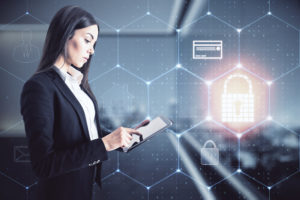Does 5g JUST Pose Problems for Cyber Security?
- Jonathan Gilpin
- June 6, 2022
- 2:27 pm
Everyone’s always looking for the next best thing when it comes to their mobile devices. All the biggest phone brands release at least a few new models every year, and there are people waiting in line every time to get their hands on them. As phones get better, so do the internet speeds that power them.
Before, 4G was the fastest type of mobile connection until they released 4G LTE. Now, that title goes to 5G internet.
But is faster necessarily better? What are the cybersecurity risks from 5G, and how do you protect your business from them?
History of 5G
What is 5G, anyway? Although no one officially owns the technology, several companies make good use of it.
Some notable examples of 5G internet providers include AT&T, T-Mobile, and Verizon. Mobile device manufacturers like Apple and Samsung have phone models that are made specifically to work with 5G data networks.
Although it was designed to provide faster and better mobile broadband services, the range is limited. When it first debuted, reviewers made note of how close a device had to be to the physical 5G towers to get the advertised speeds. Any further than a block away, you’re back to 4G speeds.
To provide 5G speeds across an entire city, you’d have to place them on nearly every block. Despite that, businesses can use 5G to acquire high speeds, low latency, and a higher network capacity.
Benefits of 5G
The invention of 5G has the ability to impact every industry in the world. With higher speeds, you get better live streaming, remote collaboration, and improved audio and video quality.
Download speed is one of the most common indicators of network speed. 5G networks use millimetre-wave technology to work off of the higher-end of the wireless spectrum.
The resulting download speeds range from 1 to 10 gigabytes per second. In comparison, 4G speeds max out at 40 megabytes per second, which is a fraction of 5G speeds.
Along with increased speeds come built-in security features. 5G separates consumer and enterprise network traffic through wireless network segmentation. It also has enhanced encryption capabilities and identity security.
Dangers of 5G
Great speeds and reliable internet do not come completely risk-free. The same high-speed connections that benefit your company also allow cyber criminals a highway into your systems.
Insecure IoT devices may leave you vulnerable to botnets, DDoS attacks, and call interception and location tracking. Once a hacker has made their way into your system, the quicker 5G network allows them to do a lot of damage before you even notice their presence.
Additionally, your network administrators may not be accustomed to implementing network slicing. While it helps enable security, your administrators may not be able to build the appropriate security to work with it.
There’s also the risk of employees working from home. While a business connection may protect your data at the workplace, your employees won’t be using that specific connection when they’re at home.
People working remotely may use their mobile devices to do some of that work on the 5G network. However, their devices aren’t always equipped with the best security measures to protect their information.
5G and Cybersecurity Risks
In late 2021, the US National Security Agency published a security advisory warning about how attackers could compromise 5G networks through the cloud. According to the report, the three main threat vectors are policy and standards, the supply chain, and 5G systems architecture.
Counterfeit components may get introduced within the 5G supply chain, which may be backdoored before they’re sold. Other countries may sell untrusted technologies and equipment that are more difficult to update, repair, or replace. Spectrum sharing is another way for malicious actors to interfere with critical communications networks.
Of course, there’s also the general risk that your data will get stolen, or your websites will suffer DDoS attacks.
Types of Mobile Cyberthreats
There are four different types of mobile security threats to keep an eye out for.
- Mobile application security threats work through illegitimate apps.
- Web-based threats download malicious content through affected websites.
- Network security threats allow cybercriminals to steal unencrypted data through public networks.
- Device security threats refer to when a device is physically stolen or lost.
One of the biggest risks of 5G use is how complex the ecosystem is. More complex technologies and operations allow for new avenues of attacks against core network services. As such, you need to be careful what kind of information you access using a mobile device.
How to Prepare a Secure Connection
The head of the UK’s National Cyber Security Centre (NCSC) has warned that it’s only a matter of time before a major cyber-attack hits the country. To avoid this, the government is making heavy investments in the cyber security sector.
Cyber security tenders are released to prevent hackers from accessing important information and their computer systems. There are tenders available in cloud security, network security, critical infrastructure, and more.
To plan for a secure 5G implementation, make sure to start early and undertake vulnerability assessments. You’ll need to enhance your monitoring and detection systems due to the speeds at which cybercriminals can deploy attacks on these new network speeds.
AI/ML-powered security solutions are another way to respond to evolving risks.
Find Cyber Security Tenders
The rise of 5G means that your business will need to make the necessary changes to protect itself. Cyber security tenders are one of the best ways to get everything you need. All you need to do is register online, find matches, and find and win the contracts.
If you want to find out more register for free today at Supply2Defence.

Understanding the UK Cyber Ecosystem
With more than 3.5 billion fans worldwide and 250 million players spanning 200 countries, football takes the trophy for the most popular sport in the world. It’s no wonder that the World Cup draws millions of people to whichever country hosts it every four years.

Construction Costs: Will the M.O.D Continue to Invest Heavily in Construction?
With more than 3.5 billion fans worldwide and 250 million players spanning 200 countries, football takes the trophy for the most popular sport in the world. It’s no wonder that the World Cup draws millions of people to whichever country hosts it every four years.

Why Blue Light Tenders Are Essential for Public Sector Suppliers
With more than 3.5 billion fans worldwide and 250 million players spanning 200 countries, football takes the trophy for the most popular sport in the world. It’s no wonder that the World Cup draws millions of people to whichever country hosts it every four years.
